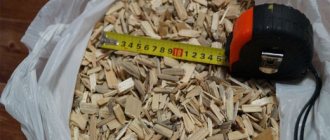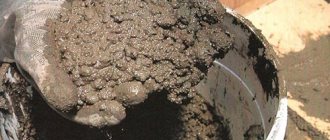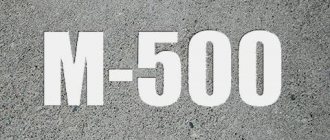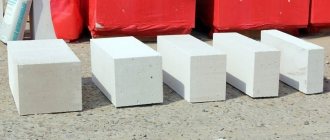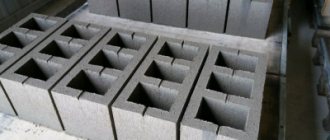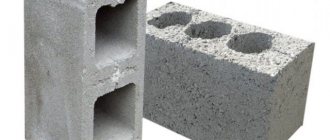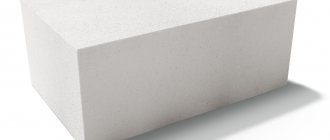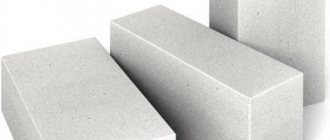SHARE ON SOCIAL NETWORKS
FacebookTwitterOkGoogle+PinterestVk
Every real man must build his house in such a way that it is strong, reliable and lasts for decades. Therefore, the choice of materials for walls is especially important, because it is very difficult to correct this mistake after building a house. Building materials from different manufacturers differ. Therefore, the size of cinder blocks, composition and other characteristics are important when constructing a building. This is exactly what will be discussed in this publication.
Cinder blocks may differ in size from different manufacturers
How to calculate the amount of cinder block?
After this, the cube is converted to the selected value and divided by the resulting volume of material.
1 m3 = 1000000 cm3 or 1000000000 mm3, then let’s look at a specific example. A cinder block for load-bearing walls of a standard size has the following parameters: 390 millimeters for length, 190 millimeters for width and height. First, let's determine the volume of one block 390 × 190 × 190 = 14079000 mm3. Now let’s see how many such products we get in one cube: 1000000000/14079000 = 71 pieces, and the result will be the same regardless of the units of measurement taken.
Next, we determine the number of partition blocks per cubic volume. It should be noted that such products have a standard size of 39 centimeters in length, 12 cm in width and 19 cm in height. Let's try to calculate differently, taking the value of cinder blocks in centimeters. As in the previous example, we calculate the volume of one product 12 × 19 × 39 = 8892 cubic meters. centimeter Now let’s find out how many of these cinder blocks will fit in one cube with a volume of 1000000/8892 = 112 pieces.
When purchasing any wall materials, you need to take 5-10 percent more. This is due to the possible destruction of the blocks during transportation, as well as loading or unloading. It should be noted that in cinder concrete masonry, a certain volume of the wall will be spent on installing mortar joints, therefore, in one cube of the assembled wall there are slightly fewer blocks than the calculated one, although this number can not be taken into account.
By purpose
The standard dimensions and purpose of the stone are linked. Full wall blocks and half-blocks are a standard range of standard sizes. Their functional purpose: ordinary (in masonry) and front. The latter are stronger and more durable.
Wall semi-block - hollow
The product is smaller in size compared to a full wall block. Available only in a hollow version. The product unit is available in two sizes: 390×120×188 mm and 390×90×188 mm.
Septal
Only one standard size of wall semi-block is used for the intended purpose - 390X120X188. The realized masonry thickness is 120 mm, which is similar to the width of the walls when they are built using standard bricks.
Decorative wall half-blocks and blocks
The products are cast in special molds, the bottom of which forms a textured pattern (“broken brick”, “wild stone”, etc.) on the front side of the products. They may have structural grooves that increase the convenience of masonry. The products look original in the masonry of fences. Their composition includes dyes that have high moisture resistance.
History of the material
Residential and public buildings, factory workshops, fences and enclosures were erected from cinder blocks. Many of these buildings have survived to this day in very satisfactory condition. Previously, cinder blocks were made from concrete, where ash was used as a filler. It could be blast furnace slag - waste from the metallurgical industry, or coal residues formed after its combustion during the operation of boiler houses, power plants, combined heat and power plants (CHP).
The use of waste to make building stone also solved the problem of their disposal. Today, despite the name, the content of ash in a concrete solution is not considered mandatory. Consists of granite crushed stone, expanded clay, broken glass, broken brick and cement mortar.
Cinder block weight, characteristics and dimensions, prices
The quality of one cinder block is checked by the weight of one cinder block. This means that the greater the mass, the thicker the walls and the better the solution is mixed during production during the vibration process. The degree of hardening also plays a role. The block should stand for about three weeks; it cannot be used before. Experienced builders determine quality in this way: the stone is weighed; if the indicator has significant deviations from the standard, it is thrown from a height of a meter. A small piece may break off from a properly made block. In the case when it falls apart, it is judged to be friable, which indicates a discrepancy between the parameters.
- Types of cinder blocks
- Specifications
- Prices
Main views and parameters
The size standard for cinder blocks depends on the fillers. In addition to blast furnace or granite slag, sand, pebbles, gravel, screenings of crushed stone, expanded clay, and sawdust are used. Volcanic grains – perlite – are also suitable as a plasticizer. The characteristics of each raw material affect the technical characteristics of the cinder block.
1. Solid stone is suitable for arranging a plinth, foundation, and load-bearing structures. Strength is provided by crushed stone, sand and pebbles added to the concrete base before processing on a vibrating machine. Depending on the amount of raw materials, the grade is determined - M100 and M125. The weight of a solid cinder block 390x190x190 is 25-28 kg. It copes well with heavy loads, but is unable to retain heat in the room.
2. For the construction of walls and interior partitions, use a cinder block with two or three channels, the percentage of which does not change. The void ratio plays a role here, from 28 to 40%. Blocks with rectangular internal cavities are easy to cut, which is convenient for installation. Depending on whether expanded clay or sand acts as an additive mixture, the following brands are released for sale: M75 and M50. The weight of a hollow cinder block ranges from 18-23 kg. There are two sizes: 390x120x188 and 390x90x188. Some blocks are made using special molds to produce a decorative textured surface.
A stone with a coefficient of 40% has the highest thermal conductivity and low strength. It is used in conjunction with other categories to protect against the cold. The semi-block weighs 10-15 kg, brand – M35. It has two wide channels intended for plasticizers, which are lightweight mixtures of sand, sawdust, and combustion waste.
When calculating the required quantity, parameters are taken into account, since the weight depends on its voidness. Preparation of concrete involves the inclusion of plasticizing substances in the solution, ensuring frost resistance and water resistance. After vibrocompression, blocks are formed, which are laid to dry for at least 10 hours.
Deviations in the geometry of the blocks are allowed with an error of plus or minus 3 mm. In case of greater disturbance, the masonry will be uneven, with seams of different thicknesses. This will lead to difficulties in construction and unnecessary consumption of mortar. Compliance with production technology ensures simple operation and short construction times. Hand-made production is possible, but the quality standard of the block and the size of the block is achieved subject to the use of special equipment and a multi-cell shape.
Properties and characteristics
In addition to conventional building materials, blocks are produced in a color palette and with imitation of rock stone or brick. For this purpose, polyurethane forms are used, which allow the side surface to be textured, which eliminates the need for additional finishing, especially for facades and plinths. Hollow cinder block 400x200x200 is suitable for decorating sidewalks and pavements.
What does the concept mean?
It is customary to distinguish between solid and hollow cinder blocks for construction. The term “solid cinder block” means a stone made from Portland cement and a mixture of slag, which uses broken concrete, crushed brick and other waste. Such a stone has no voids at all or has them in small quantities.
If in a hollow stone the figure reaches 40% voids, then everything is different here. That is why this raw material is usually used for the construction of structures where strength comes first.
Requirements according to GOST
GOST 6133-99
- there should be no voids in the stone;
- the presence of technological voids for block capture is allowed;
- the stone can be face or ordinary, intended for laying external and internal walls;
- the raw material has the shape of a rectangular parallelepiped;
- the end must be flat, a tongue-and-groove system is allowed;
- weight should not exceed 31 kg;
- corners can be straight or rounded;
- Deviation from standard dimensions by +-3 mm is allowed.
Defects of the cinder block, as well as the presence of grease stains of more than 10 mm on the façade of the stone, are not allowed. Strength is standardized according to tables, depending on the product labeling.
Pros and cons of the material
The appearance of cinder blocks is directly related to man’s natural desire for waste-free production. In the USSR in the post-war years, production developed at a rapid pace. Metallurgical plants were literally overgrown with mountains of slag. Then the decision came to use this waste to create building materials.
The slag served as a filler for the cement-sand mixture. The resulting mass was molded into large “bricks”. The finished blocks were too heavy - they weighed 25-28 kg. To reduce weight, voids were made in them. Hollow specimens turned out to be a little lighter - from 18 to 23 kg with standard dimensions.
The name cinder blocks is still used today, although not only slag, but also other components are used as fillers. In modern blocks you can find granite screenings or crushed stone, river gravel, broken glass or expanded clay, and volcanic mass. The production of cinder blocks is most often carried out by small businesses. Small private enterprises produce building blocks on vibrating machines, filling several molds with cement mixture at once. After molding and compacting, the “bricks” gain strength for at least a month.
Cinder blocks have certain advantages and disadvantages.
- The advantage of block building material, first of all, is its low cost. That is why the material is in wide demand.
- This building material also has other positive characteristics. For example, blocks do not change their size after laying out. The structure will not shrink, which means that design calculations will not be adjusted during the construction process.
- The strength and hardness of the “big brick” determine its service life. This is neither more nor less – a whole 100 years! Durability is not calculated, but time-tested. There are many buildings from the middle of the last century that “stand firmly on their feet.” The houses are not lopsided or falling apart, only the facades require cosmetic repairs.
- The blocks react poorly to ultraviolet radiation and temperature changes. The material is not edible for rodents and insects.
- Thanks to the increased size, construction is proceeding at a rapid pace. Much less masonry mixture is used for laying blocks than, for example, for a brick wall of similar sizes.
- No street noise can be heard behind a cinder block wall, because it is capable of absorbing sounds.
- Finally, if you have simple equipment and desire, blocks can be made at home, which will further reduce the cost of construction.
The building material has as many disadvantages as advantages.
These include the following characteristics.
- Unprepossessing appearance.
- It is problematic to attach to walls due to voids in the body of the block.
- The need for cladding to make the building attractive and protect the building material from external moisture.
- Fragility. If it falls during work, during transportation or loading, the unit may break.
- High thermal conductivity. Without additional insulation, the building does not retain heat well.
- Wide tolerance limits. Dimensions may differ significantly from nominal.
Weight of one cinder block
The mass of a cinder block directly depends on its actual volume: the stone can be solid or hollow. There are three categories of slag wall stones on the market, so let’s put each group into a separate weight category:
- Full-bodied. The absence of voids increases the strength of the cinder block, but makes it much heavier. Such stones can be used for load-bearing walls and foundations; their weight varies between 25-29 kg.
- Hollow. Such stone is usually used only for the construction of walls, including load-bearing structures. The weight of one piece is 12-23 kg.
- Semi-block. In such stone, voids predominate, so the material is used only for interior partitions. Cinder block weight: 9-13 kg.
According to GOST 6433-99 “Concrete wall stones”, the density of hollow cinder blocks should not exceed 1650 kg/cub.m., and solid cinder blocks – no more than 2200 kg/cub.m.
Naturally, in addition to the % voidness and density, the weight of the stone is also affected by the dimensions, so a large cinder block 200 200 400 will have the greatest weight.
| Size | Block composition | Emptiness, % | Weight | Note |
| 390x190x188 | Sand-cement | 40 | 10 | Open bottom |
| 390x190x188 | Sand-cement | 40 | 12 | With closed bottom |
| 390x190x188 | Expanded clay concrete | 40 | 10 | With closed bottom |
| 390x190x188 | Sand-cement | 30 | 14,5 | With closed bottom |
| 390x190x188 | Sand-cement | 28 | 16 | With closed bottom |
| 390x90x188 | Sand-cement | 30 | 10 | Double-hollow |
| 390x90x188 | Expanded clay concrete | 30 | 9 | Double-hollow |
| 390x190x188 | Sand-cement | — | 28 | Full-bodied |
| 390x190x188 | Expanded clay concrete | — | 25 | Full-bodied |
| 400x200x200 | Sand-cement | — | 29 | Full-bodied |
| 400x200x200 | Expanded clay concrete | — | 26 | Full-bodied |
Cinder blocks pros and cons.
The advantages of blocks include:
- durability and strength;
- resistance against fungi and rodents;
- fire resistance;
- fairly low thermal conductivity (especially hollow ones);
- light weight and increased dimensions, allowing for quick construction;
- variety of block shapes and voids in them;
- ease of manufacture allows for off-site production.
Along with the advantages, the blocks also have the following disadvantages:
- low level of noise absorption;
- high level of water absorption;
- high thermal conductivity (solid products);
- It is difficult to communicate through them.
These disadvantages explain their frequent use for the construction of ancillary buildings (garages, summer kitchens, etc.), as well as as an inexpensive facing material, curb stones and paving slabs.
What deviations are allowed in the production of cinder blocks
Blocks that have the following defects cannot be sold:
- deviations in length and width are more than 3, and heights are more than 4 mm;
- the curvilinearity of horizontal edges is more than 3 mm, and of vertical edges – 2 mm;
- shell depth exceeds 4 mm;
- nodules and depressions more than 2 mm;
- chips on edges more than 5 mm deep and length more than 50 mm.
Making cinder blocks yourself
Handy amateur builders make do with cinder blocks made on their own directly at the construction site. To do this, they need a form and materials (water, cement and fillers). Construction waste (shards of brick, glass, etc.) is often used as the latter. This method of construction allows you to save significant money.
APPENDIX 1 Reference
1. Thermal conductivity of concrete stones
| Name concrete | Thermal conductivity of concrete stones, W/(m °C), at average concrete density, kg/m3 (for operating conditions A/B) | |||||
| 1000 | 1200 | 1400 | 1600 | 1800 | 2000 | |
| Tufobeton | – | 0,41/0,47 | 0,52/0,58 | 0,70/0,81 | 0,87/0,99 | – |
| Pumice concrete | 0,30/0,34 | 0,40/0,43 | 0,49/0,54 | 0,62/0,68 | – | – |
| Concrete on volcanic slag | 0,29/0,35 | 0,41/0,47 | 0,52/0,58 | 0,64/0,70 | – | – |
| Concrete based on granulated blast furnace slag | – | 0,47/0,52 | 0,52/0,58 | 0,58/0,64 | 0,70/0,81 | 0,83/0,99 |
| Concrete based on fuel (boiler) slags | 0,38/0,44 | 0,48/0,54 | 0,59/0,65 | 0,72/0,78 | 0,85/0,93 | 0,92/1,08 |
| Expanded clay concrete on expanded clay sand | 0,33/0,41 | 0,44/0,52 | 0,56/0,65 | 0,67/0,79 | 0,80/0,92 | – |
| Expanded clay concrete on quartz sand | – | 0,48/0,55 | 0,63/0,69 | 0,72/0,83 | 0,85/0,9 | 0,99/1,13 |
| Shungizite concrete | 0,33/0,38 | 0,44/0,50 | 0,56/0,64 | – | – | – |
Notes:
1. Operating conditions A and B according to SNiPII-3-79.
2. In table. Table 1 shows the thermal conductivity indicators of a number of concretes used for the manufacture of effective and conditionally effective stones of the SKTs, SKI and SKSh types.
3. When calculating the heat transfer resistance of an external wall made of solid stones, it is necessary to increase the thermal conductivity value of concrete by 3%.
2. Thermal conductivity of whole stones
table 2
| Name of concrete | Thermal conductivity of whole stones, W/(m °C), at average stone density (including cracks), kg/m3 (for operating conditions A/B) | |||||
| 750 | 900 | 105 | 1200 | 1350 | 1450 | |
| Tufobeton | – | 0,31/0,34 | 0,37/0,39 | 0,44/0,49 | 0,51/0,55 | – |
| Pumice concrete | 0,27/0,29 | 0,31/0,33 | 0,34/0,37 | 0,41/0,43 | – | – |
| concrete on volcanic slag | 0,27/0,29 | 0,31/0,34 | 0,37/0,39 | 0,42/0,44 | – | – |
| Concrete based on granulated blast furnace slag | – | 0,34/0,37 | 0,37/0,39 | 0,39/0,42 | 0,44/0,49 | 0,50/0,57 |
| Concrete based on fuel (boiler) slags | 0,30/0,32 | 0,35/0,37 | 0,39/0,42 | 0,45/0,48 | 0,50/0,55 | 0,57/0,62 |
| Expanded clay concrete on expanded clay sand | 0,28/0,31 | 0,33/0,37 | 0,38/0,42 | 0,43/0,48 | 0,49/0,53 | – |
| Expanded clay concrete on quartz sand | – | 0,35/0,39 | 0,41/0,45 | 0,46/0,51 | 0,54/0,58 | 0,65/0,69 |
| Shungizite concrete | 0,28/0,30 | 0,33/0,38 | 0,38/0,41 | – | – | – |
Notes:
1. Operating conditions A and B according to SNiPII-3-79.
2. In table. Table 2 shows the thermal conductivity values of individual effective and conditionally effective stones used for laying external walls.
3. Thermal conductivity values are given for hollow stones with the dimensions and shape of the voids indicated in and. The thermal conductivity of stones made from other types of concrete and with other voids should be determined by thermal testing.
4. When calculating the heat transfer resistance of an outer wall made of whole hollow stones, it is necessary to increase the thermal conductivity value by 10%.
3. Thermal conductivity of longitudinal halves of stones
| Name of concrete | Thermal conductivity of longitudinal halves of stones, W/(m °C), with average density of longitudinal halves (including cracks), kg/m3 (for operating conditions A/b) | |||||
| 820 | 980 | 1150 | 1310 | 1470 | 1600 | |
| Tufobeton | – | 0,33/0,36 | 0,39/0,41 | 0,48/0,53 | 0,90/0,60 | – |
| Pumice concrete | 0,29/0,31 | 0,33/0,35 | 0,37/0,40 | 0,45/0,47 | – | – |
Concrete on volcanic slag | 0,29/0,31 | 0,33/0,36 | 0,40/0,42 | 0,46/0,48 | – | – |
| Concrete based on granulated blast furnace slag | – | 0,36/0,39 | 0,39/0,41 | 0,43/0,46 | 0,49/0,54 | 0,56/0,63 |
| Concrete based on fuel (boiler) slags | 0,32/0,34 | 0,37/0,39 | 0,42/0,45 | 0,49/0,53 | 0,55/0,60 | 0,61/0,68 |
| Expanded clay concrete on expanded clay sand | 0,30/0,33 | 0,35/0,39 | 0,41/0,45 | 0,47/0,52 | 0,54/0,56 | – |
| Expanded clay concrete on quartz sand | – | 0,37/0,41 | 0,43/0,47 | 0,49/0,54 | 0,59/0,63 | 0,70/0,75 |
| Shungizite concrete | 0,30/0,32 | 0,35/0,38 | 0,41/0,43 | – | – | – |
Notes:
1. Operating conditions A and B according to SNiPII-3-79.
2. In table. Table 3 shows the thermal conductivity values of individual effective and conditionally effective halves of stones used for laying external walls.
3. Thermal conductivity values are given for hollow stones with the dimensions and shape of the voids indicated on. The thermal conductivity of stones made from other types of concrete and with other voids should be determined by thermal testing.
4. When calculating the heat transfer resistance of an external wall made of hollow stones, it is necessary to increase the thermal conductivity value by 10%.
Cinder block size: standard and required quantity for construction
Knowing the height of the cinder block, as well as other standard parameters of the material, you can easily convert these values into m³. It is much more convenient to use this unit of measurement, since the amount of cinder block required for construction is usually calculated in m³.
To calculate the required number of blocks, there are special formulas and calculators
When starting construction work, it is extremely important to correctly and accurately determine the required amount of material. Since the standard parameters of cinder blocks differ from the sizes of conventional bricks, the calculations take place according to a completely different scheme
First of all, you need to know how many cinder blocks are in the cube. In order to calculate the volume of each unit, you should multiply the width, height and length of the building material in cm. Next, 1 million cm³ must be divided by the resulting number. As a result, it will be possible to determine how many cinder blocks are in one cube. There are usually 72 standard cinder blocks in one m³.
Many people believe that one pallet of cinder concrete blocks is equal to 1 m³. This is a misconception that often leads to errors during calculations. A standard pallet holds 60 stones, which is slightly less than 1 m³.
Knowing the exact dimensions of the cinder block, it is easy to calculate the required quantity
Calculation of the amount of material, sizes of cinder blocks and prices
During construction, it is important to know how many blocks are needed for 1 m². Wall thickness plays an important role in these calculations.
For example, to build 1 m² of wall, the thickness of which is equal to half the whole block, you will need 13.6 pieces. If the wall is formed into a whole block, the amount of material should be doubled, that is, 27.2 stones will be needed. It must be taken into account that in practice fewer blocks are required, since the thickness of the mortar joint is not taken into account during calculations.
As for cost, the most expensive are the base and foundation blocks M100-125. Wall and partition stones M50-75 are a little cheaper. Thermal insulation products are inexpensive, but their strength is low - M35.
Table of sizes and prices for cinder blocks of different types and brands:
| View | Size, cm | Brand | price, rub. per piece |
| Full-bodied | 40x20x20 | M50 M75 M100 | 27 30 34 |
| Solid with expanded clay | 39x19x19 39x9x19 | M75 M50 | 43 27 |
| Double-hollow | 38.8x19x18.8 | M75 | 35 |
| Three-hollow | 39x19x18.8 | M50 | 31 |
| Quadruple-hollow | 39x19x18.8 | M75 | 28 |
| Septal hollow | 39x12x19 39x9x18.8 | M75 M50 | 26 17 |
| Decorative | 39x19x18.8 | M75 | 65 |
It should be noted that the price is approximate, since how much one cinder block costs is influenced by many factors, including the manufacturer, and the cost of an expanded clay concrete block is twice as high as the price of a cinder block.
What determines the cost of laying walls from such blocks?
The cost of masonry is influenced by the following factors:
- this is an internal or load-bearing wall;
- what type of blocks are used;
- complexity of masonry (the need to perform decorative work);
- deadlines for completing work.
Construction companies do not calculate the cost of work according to any one standard.
In most cases, the customer is provided with a price list, the numbers in which may differ depending on the chosen company. Based on these price lists, estimates are drawn up.
An important factor is also the amount of work required. Typically, the less work that needs to be done, the higher the cost per completion. The cost of the service also increases depending on the type of wall. If it is straight without windows or openings, the price will be lower than if it were necessary to make an arch or window of a non-standard size.
In winter there is a seasonal increase in prices. In Moscow and other regions of the country, the cost of masonry in the cold season is 5-10% higher than, for example, in summer or spring. The price of laying solid materials will differ significantly from the cost of laying hollow ones, since the weight of the latter is much less.
| City | Cost per m3, rubles |
| Moscow | 400 — 2200 |
| Saint Petersburg | 700 — 1800 |
| Ekaterinburg | From 1000 to 2500 |
| Vladivostok | From 600 to 2100 |
| Rostov-on-Don | From 550 to 2300 |
How to make the right choice
What should you pay attention to when purchasing piece cinder block stone? You need to use the services of certified manufacturers. This approach can most fully guarantee the high quality of building materials.
It is also necessary to inquire about the exact composition of the original ingredients and the environmental certificate of suitability for use in residential construction.
It is advisable to familiarize yourself with laboratory test reports and find out strength characteristics such as frost resistance, weather resistance, and water resistance.
An external inspection is required. The product must have the shape of a regular parallelepiped. The dimensions of the edges should not differ by more than 1...2 mm, both on one stone and on any other randomly selected from the proposed batch. Concrete on external surfaces must be smooth, without signs of looseness or imperfection. The voids must be symmetrical and in no case connected to external planes in the form of cavities.
Advantages and disadvantages of cinder block
The advantages of this wall material include:
- Relatively low price of the product.
- Due to the large size of one block, construction time is significantly reduced, which means the cost of work is reduced.
- The masonry technique is simple; you can do it yourself.
- A variety of filler compositions for concrete mixtures. You can always choose a material that suits its characteristics specifically for you.
- Long service life. Standard service life is 100 years.
- By using decorative cinder block, you do not need to spend money on plastering or cladding the building.
- High sound insulation. Like any concrete, cinder block absorbs sound.
Disadvantages of cinder blocks:
- Heavy weight of some types of products.
- Unsightly appearance. If you can’t buy decorative cinder blocks in your area, then it’s difficult to find a craftsman who can beautifully lay out this wall stone.
- After the Chernobyl accident, people began to treat this product with caution. There were, and still are, many rumors that the results of its testing for radioactivity can be unpredictable, and that the presence of a bouquet of elements of the periodic system in blast furnace slag can be potentially hazardous to health.
But whoever is forewarned is forearmed. And this very significant (maybe hypothetically) disadvantage can always be balanced by advantage No. 4.
The main thing is to approach the choice of manufacturer responsibly. Find out what equipment he uses, how production technology is followed, what filler he uses, and where it comes from.
Useful tips
If you decide to build a house from cinder blocks, then you first need to build the strongest and highest possible foundation. Experts recommend turning to tape options.
We must not forget that cinder block walls are very dense. Because of this, many craftsmen are faced with the problem of laying pipes and electrical wiring. As a rule, specialists in such cases turn to special equipment. That is why it is advisable to think about carrying out this work in advance if you are going to do it yourself.
When choosing this building material, always pay special attention to its filler. The best options are those with shell rock, expanded clay, sawdust and crushed stone.
They are safe and environmentally friendly.
Be sure to ensure the integrity of the cinder blocks when selecting them.
In addition, you should pay attention to the identity of the geometry of several elements located in different pallets
When it comes to transporting cinder blocks, pallets are most often used here. However, you can also resort to simple storage. Blocks can only be stored on pallets. They should be located under a canopy to protect them from the harmful effects of various atmospheric precipitations. Hollow elements should be placed with the voids facing down.
Experts say that it is quite possible to check the quality of a cinder block using an ordinary 15 mm nail - try sticking it into the material below with your own hands. If a nail goes into it, this will indicate that the quality of the blocks is not the highest.
Please note that cinder blocks that were produced without the use of a special vibrating machine are much inferior in strength characteristics to elements that were produced using a similar technique. They can only be used in the construction of simple non-residential premises.
Cinder blocks cannot boast of high thermal insulation characteristics, such as, for example, foam blocks
Therefore, if you are building a residential building from these materials yourself, then you will have to pay special attention to the thickness of the seams. If they turn out to be too thick, the building will turn out cold - heat will simply escape through the seams to the outside
An excessively thick layer of mortar (more than 1.5 cm) will negatively affect the thermal insulation qualities of the walls.
If you decide to finish cinder blocks with a plaster mixture, then first you need to prepare them for this work. Otherwise, the plaster simply will not stick to the blocks.
Before proceeding with the construction of this or that building from cinder blocks, you need to correctly calculate their required quantity. To do this, you need to calculate how many parts there will be in 1 m3. For example, a material with parameters 390x190x188 mm can be calculated in this way: 39x19x18.8 = 13930; 1000000 (cube volume): 13930=71. There will be 71 blocks in 1 m3.
Don't skimp on purchasing cinder blocks. Too cheap materials may turn out to be of low quality or even dangerous from an environmental point of view.
The pros and cons of cinder blocks are discussed in the following video.
Cons of cinder blocks
But, despite so many advantages, cinder blocks also have their own disadvantages, which you should also be aware of when choosing this material for the construction of buildings. The main disadvantages of cinder blocks include:
- the characteristics of blocks in one batch can vary significantly when manufactured at home;
- if the filler material of the blocks is subject to destruction (for example, sawdust), then the actual service life of walls made of such material may be lower than the calculated one;
- when purchasing industrially produced cinder blocks, you can purchase a material that is not environmentally friendly - production waste can emit harmful substances;
- cinder blocks are quite difficult to plaster due to poor adhesion of the plaster to the block material;
- blocks are susceptible to destruction under the influence of freezing moisture penetrating into the pores of artificial stones (when constructing walls made of cinder blocks, it is recommended to install eaves overhangs of sufficient length with gutters for draining rainwater and a reliable blind area around the perimeter of the walls).
As you can see, there are also disadvantages. But for the construction of a bathhouse, garage or small utility rooms they are not decisive, and cinder blocks are quite suitable for the construction of their walls. Therefore, you should not be afraid to choose this material if a comparison of the cost of construction shows that construction from cinder blocks will cost less than brick walls or the construction of a log house.
How many cinder blocks in a cube
With these dimensions, 3×5 = 15 blocks will fit in one row on a pallet.
It is known that the weight of a hollow cinder block is 13 kilograms, and a solid one is 20 kilograms. From this value it can be determined that the mass of one row of products will be 15 × 13 = 195 kg. Taking this value into account, you can find out that the maximum number of rows on a pallet will be no more than five 1000/195 = 5, so in one pallet there will be 5 × 15 = 75 pieces of such cinder blocks.
Now let's deal with solid blocks. As we have already said, the mass of such a product corresponds to 20 kilograms, so one row will weigh 15 × 20 = 300 kilograms. This means that you can lay no more than three rows of such products, which is 3×15 = 45 pieces of cinder blocks in a pallet.
Home » Materials for the garden.
Solution consumption
Standard sizes of floor tiles
When working with a brick wall, it is customary to use a mixture containing 4 parts cement and one part sand. In this case, it is necessary to add the required amount of water so that the mixture obtains the desired consistency.
To lay a wall, you need to make the mortar correctly Source i.ytimg.com
Such a solution would be suitable for solid blocks. However, if there are voids in the block, then the proportions of the solution must be taken differently: 8 parts of cement, 1 part of sand and the required amount of water.
The amount of solution can be measured in liters. It should be taken into account that usually for a cubic meter of blocks the consumption is 210-250 liters.
The size of cinder blocks is clearly shown in this video:
Unit Specifications
Along with the dimensions, its technical characteristics, which are specified in GOST 6133-99, are also of great importance.
Emptiness
This indicator is understood as the total volume of cavities (in% of the total volume), which are empty spaces of a certain shape. In accordance with this, 2 classes of products are distinguished:
- Hollow (voids range from 30 to 40%).
- Solid - does not contain any cavities.
In this case, the unfilled parts can be of different shapes, which can be clearly seen in the diagram.
Weight
The weight of the block is determined by its dimensions and the presence of voids. Accordingly, there are 3 types of products (see table).
| Class | dimensions, mm | Weight, kg |
| full-bodied | standard | 25-28 |
| hollow | 18-25 | |
| slag half-block | 390*120*188 | 10-15 |
Strength
The strength of this material is defined as the maximum load (in kilograms) that 1 square centimeter of the surface of the finished product can withstand (kg/cm2). Expressed by brand strength indicator:
- M35;
- M50;
- M75;
- M100.
For example, M75 can withstand a maximum pressure of 75 kilograms per square centimeter, and M35 - 35 kg/cm2. The strength of a product directly depends on its composition, which can be clearly seen from the table.
Thermal conductivity
The indicator is defined as the amount of heat that a 1 meter thick cinder block transmits when the temperature difference between the outside and inside of the building is 1 degree Celsius. Accordingly, it is measured in W/(m*oC).
The thermal conductivity coefficient of the finished product is quite low among building materials and ranges from 0.27 to 0.64 W/(m*oC). For comparison: for concrete this figure is about 1.25-1.75, for stone 1.45.
Low thermal conductivity is associated with voids in which air is located. It conducts heat very poorly; accordingly, the heated environment has difficulty transferring excess heat to the outside.
Consumer qualities and advantages of cinder block
Along with its dimensions and other technical parameters, the consumer qualities of the material are also interesting, which allow you to choose the right one for the construction of a particular structure:
Chemical additives recommended for preparing concrete
3.1. Air-entraining
Saponified wood resin SDO according to TU 81-05-02-78.
Neutralized air-entraining resin SNI according to TU 81-05-75-74.
Foaming agent PO-1 according to GOST 6948-81.
3.2. Foaming
Glue rosin foaming agent based on bone glue according to GOST 2067-80. pine rosin according to GOST 19113-84 and caustic soda according to GOST 2263-79.
Resin-anonine foaming agent based on soap root according to OST 1308.
Alkyl sulfate paste according to TU 30-10755-75.
3.3. Plasticizing
Sulfite-yeast mash SDB according to OST 81-79-71 or TU 81-04-225-73.
Surface-active lye PASH-1 according to TU 6-03-26-77.
Synthetic plasticizing additive SPD according to TU 88-101-253-77
Superplasticizer S-3 according to TU 6-14-29-258-79.
Sodium ethyl siliconate GKZh-10 and sodium methyl siliconate GZhK-11 according to TU 6-02-6978-72.
Polyhydrosiloxane GZhK-94 according to GOST 10834-76.
3.4. Hardening accelerators
Calcium chloride CC according to GOST 450-77.
Calcium nitrate NK according to TU 6-08-867-79.
Nitrite-nitrate-chloride NIHK according to TU 6-18-194-76.
